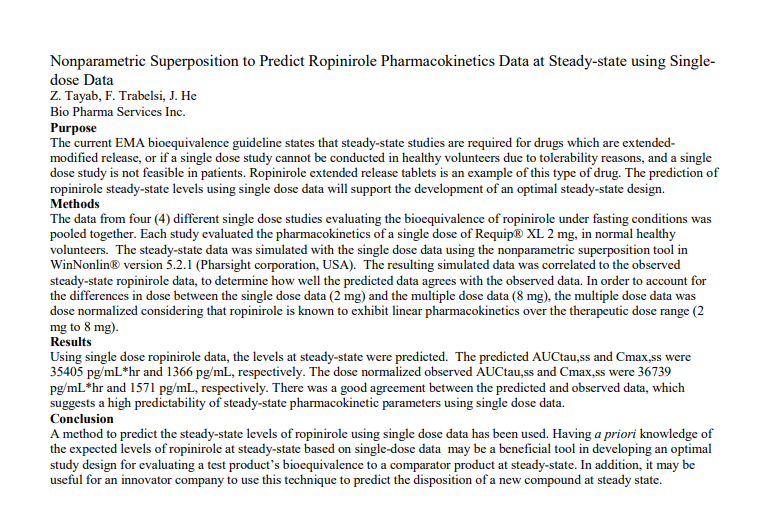Nonparametric Superposition to Predict Ropinirole Pharmacokinetics Data at Steady-state using Single-dose Data
PRESENTED TO: BioPharma Services Inc., Toronto, ON, Canada
PRESENTED BY: Z. Tayab, F. Trabelsi, J. He
PURPOSE
The current EMA bioequivalence guideline states that steady-state studies are required for drugs which are extended modified release, or if a single dose study cannot be conducted in healthy volunteers due to tolerability reasons, and a single dose study is not feasible in patients. Ropinirole extended release tablets is an example of this type of drug. The prediction of ropinirole steady-state levels using single dose data will support the development of an optimal steady-state design.
METHODS
The data from four (4) different single dose studies evaluating the bioequivalence of ropinirole under fasting conditions was pooled together. Each study evaluated the pharmacokinetics of a single dose of Requip® XL 2 mg, in normal healthy volunteers. The steady-state data was simulated with the single dose data using the nonparametric superposition tool in WinNonlin® version 5.2.1 (Pharsight corporation, USA). The resulting simulated data was correlated to the observed steady-state ropinirole data, to determine how well the predicted data agrees with the observed data. In order to account for the differences in dose between the single dose data (2 mg) and the multiple dose data (8 mg), the multiple dose data was dose normalized considering that ropinirole is known to exhibit linear pharmacokinetics over the therapeutic dose range (2 mg to 8 mg).
RESULTS
Using single dose ropinirole data, the levels at steady-state were predicted. The predicted AUCtau,ss and Cmax,ss were 35405 pg/mL*hr and 1366 pg/mL, respectively. The dose normalized observed AUCtau,ss and Cmax,ss were 36739 pg/mL*hr and 1571 pg/mL, respectively. There was a good agreement between the predicted and observed data, which suggests a high predictability of steady-state pharmacokinetic parameters using single dose data.
CONCLUSION
A method to predict the steady-state levels of ropinirole using single dose data has been used. Having a priori knowledge of the expected levels of ropinirole at steady-state based on single-dose data may be a beneficial tool in developing an optimal study design for evaluating a test product’s bioequivalence to a comparator product at steady-state. In addition, it may be useful for an innovator company to use this technique to predict the disposition of a new compound at steady state.




